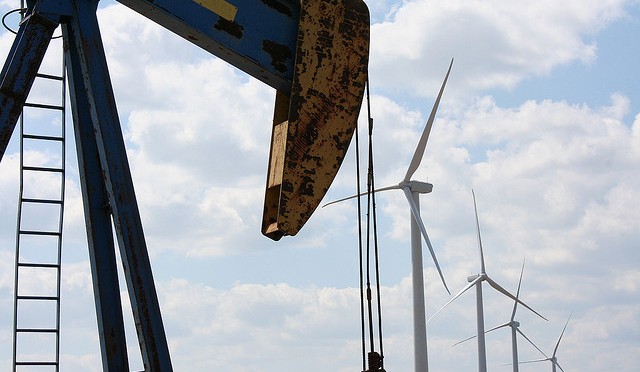The story of Texas wind energy is a success, but it’s an odd history.
In 1999, when Texas deregulated the energy market, a deal was struck to include a Renewable Portfolio Standard (RPS), a requirement that power companies source a certain amount of their electricity from renewable energy by certain dates. Texas surpassed the original targets, as well as subsequently increased targets, eventually making Texas the U.S. wind leader. In fact, the wind industry’s success has been an integral part of the “Texas Miracle” of job creation, especially in West Texas, which hasn’t seen an economic boom like this since before the Great Depression.
However, state Senator Troy Fraser (R-Horseshoe Bay) and other legislators think that, because Texas blew past its wind goals, we can call it a “mission accomplished” and repeal the RPS. Repealing Texas’ wind goals at this time, though, could undermine Texas’ wind industry, potentially eliminating thousands of jobs and halting millions of investment dollars Texas receives every year.
The American Wind Energy Association (AWEA) recently released its annual U.S. Wind Industry Market Report for 2014. The report puts Texas on a pedestal, highlighting how the Lone Star State is home to 37 percent of newly installed wind capacity in 2014. “Of the 12,700 megawatts (MW) under construction across the country, approximately 7,000 MW are in Texas. Unsurprisingly, Texas leads the country with over 17,000 wind industry jobs.” In the list of the Top 10 Public Utilities and Public Utility Districts with Wind Capacity on System across the U.S., Texas’ own CPS Energy in San Antonio and Austin Energy rank first and third, respectively.
Unwarranted opposition
Senator Fraser claims he is pushing for legislation that would repeal the RPS because he wants to end subsidies. That may be true, but why doesn’t he also repeal the massive subsidies Texas currently gives to the fossil fuel industry, which dwarf support for wind and solar? According to the Dallas Morning News, Texas incentives for wind are only $12 million to $40 million annually, while the natural gas industry received $1 billion in taxpayer subsidies in one year. In fact, fossil fuels account for an “estimated 99.6 percent of all state subsidies, mostly as tax exemptions.”
If you build it, they will come…and they did (for now at least)
The law that supported establishment of the Competitive Renewable Energy Zone (CREZ) transmission project is also on the chopping block with Senator Fraser’s bill, despite the direct and indirect benefits that Texas has realized through this innovative policy. Approved by the Public Utility Commission of Texas (PUCT) in 2008, the CREZ lines are a 3,600 mile network of transmission lines that connect remote West Texas wind energy to the eastern cities – enough energy to power 3.7 million to 7.4 million homes – and increase the available wind power supply by a whopping 50 percent. Texas’ record level of wind plant construction is driven largely by the completion of the state’s CREZ project.
This innovative policy solved the industry’s chicken-or-the-egg challenge, wherein transmission providers were not likely to build lines to remote areas without some kind of power plant, and wind farm developers would not build projects in areas without a connection to power lines. The CREZ lines have also been an important infrastructure upgrade for natural gas facilities, too.
Uncertainty leads to economic loss
At the end of 2012, the wind industry experienced a lapse in its primary federal tax incentive, the Production Tax Credit (PTC). This lapse drove a 92 percent drop in installations in 2013. By the following year, the incentives were renewed and the U.S. wind energy industry rebounded, adding over 22,500 full-time equivalent jobs, bringing the total to 73,000. According to AWEA, “this is a partial rebound from the nearly 30,000 jobs that were lost in 2013 due to the lapse of the PTC at the end of 2012.”
These ups-and-downs underscore the need for certainty in this industry – something that shouldn’t change based on political winds.
Losing our edge
While Texas currently leads in wind energy, the state could lose its competitive edge if Senator Fraser and others accomplish their goal of rolling back the RPS. The other top wind states in 2014 were Oklahoma, Iowa, Washington, and Colorado. As AWEA notes, the Midwest, namely Michigan and North Dakota, is also a burgeoning force of power, thanks in large part to new power lines similar to the CREZ lines. And as we saw in Texas, where there is investment, there are also jobs. If Texas repeals the RPS, legislators will also be pulling the rug out from under tens of thousands of Texans who work in the wind sector, as companies will likely move to other states to set up shop.
AWEA’s report goes on to say Texas’ “good, stable policy is behind the continued success in wind energy.” It also illustrates demand for wind energy is at an all-time high, while costs continue to decline. Texas can rest on its laurels and declare “mission accomplished” in a flight suit, or we can continue to support and invest in clean energy as a community.
To tell the Texas legislature that they should oppose this bill, go to Power of Wind here.


